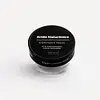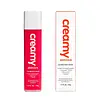What's inside
What's inside
 Key Ingredients
Key Ingredients

 Benefits
Benefits

 Concerns
Concerns

 Ingredients Side-by-side
Ingredients Side-by-side

Water
Skin ConditioningCoco-Caprylate/Caprate
EmollientCetearyl Olivate
Butyrospermum Parkii Butter
Skin ConditioningPentylene Glycol
Skin ConditioningCetearyl Alcohol
EmollientGlycerin
HumectantSorbitan Olivate
EmulsifyingGlyceryl Stearate
EmollientGlyceryl Caprylate
EmollientRosa Canina Fruit Oil
EmollientPropanediol
SolventSilica
AbrasiveHydroxyethylcellulose
Emulsion StabilisingHydrolyzed Sodium Hyaluronate
Skin ConditioningTocopherol
AntioxidantIsocetyl Stearoyl Stearate
EmollientCetyl Alcohol
EmollientRosa Gallica Flower Extract
AstringentCetearyl Glucoside
EmulsifyingSodium Hyaluronate
HumectantAlcohol
AntimicrobialSodium Phytate
Citric Acid
BufferingParfum
MaskingBiosaccharide Gum-1
HumectantBenzyl Alcohol
PerfumingSodium Levulinate
Skin ConditioningGlucose
HumectantSodium Anisate
AntimicrobialDehydroacetic Acid
PreservativeWater, Coco-Caprylate/Caprate, Cetearyl Olivate, Butyrospermum Parkii Butter, Pentylene Glycol, Cetearyl Alcohol, Glycerin, Sorbitan Olivate, Glyceryl Stearate, Glyceryl Caprylate, Rosa Canina Fruit Oil, Propanediol, Silica, Hydroxyethylcellulose, Hydrolyzed Sodium Hyaluronate, Tocopherol, Isocetyl Stearoyl Stearate, Cetyl Alcohol, Rosa Gallica Flower Extract, Cetearyl Glucoside, Sodium Hyaluronate, Alcohol, Sodium Phytate, Citric Acid, Parfum, Biosaccharide Gum-1, Benzyl Alcohol, Sodium Levulinate, Glucose, Sodium Anisate, Dehydroacetic Acid
Water
Skin ConditioningCyclopentasiloxane
EmollientCetearyl Olivate
Propanediol
SolventSorbitan Olivate
EmulsifyingPersea Gratissima Oil
Skin ConditioningPentylene Glycol
Skin ConditioningCoco-Caprylate/Caprate
EmollientDipentaerythrityl Hexacaprylate/Hexacaprate
EmulsifyingPhytosterols
Skin ConditioningGlyceryl Caprylate
EmollientButylene Glycol
HumectantSodium Acrylates Copolymer
4-T-Butylcyclohexanol
MaskingTocopheryl Acetate
AntioxidantBisabolol
MaskingOlea Europaea Fruit Oil
MaskingGlycerin
HumectantSargassum Filipendula Extract
Skin ProtectingLecithin
EmollientHypnea Musciformis Extract
Skin ProtectingDimethicone/Vinyl Dimethicone Crosspolymer
Skin ConditioningSodium Gluconate
Skin ConditioningCaprylic/Capric Triglyceride
MaskingGlyceryl Undecylenate
EmollientSorbitan Oleate
EmulsifyingCentella Asiatica Extract
CleansingAscorbyl Palmitate
AntioxidantHydroxymethoxyphenyl Decanone
Skin ConditioningBenzyl Alcohol
PerfumingPotassium Sorbate
PreservativeSodium Benzoate
MaskingBenzoic Acid
MaskingDextran
Palmitoyl Tripeptide-8
Skin ConditioningSorbic Acid
PreservativeWater, Cyclopentasiloxane, Cetearyl Olivate, Propanediol, Sorbitan Olivate, Persea Gratissima Oil, Pentylene Glycol, Coco-Caprylate/Caprate, Dipentaerythrityl Hexacaprylate/Hexacaprate, Phytosterols, Glyceryl Caprylate, Butylene Glycol, Sodium Acrylates Copolymer, 4-T-Butylcyclohexanol, Tocopheryl Acetate, Bisabolol, Olea Europaea Fruit Oil, Glycerin, Sargassum Filipendula Extract, Lecithin, Hypnea Musciformis Extract, Dimethicone/Vinyl Dimethicone Crosspolymer, Sodium Gluconate, Caprylic/Capric Triglyceride, Glyceryl Undecylenate, Sorbitan Oleate, Centella Asiatica Extract, Ascorbyl Palmitate, Hydroxymethoxyphenyl Decanone, Benzyl Alcohol, Potassium Sorbate, Sodium Benzoate, Benzoic Acid, Dextran, Palmitoyl Tripeptide-8, Sorbic Acid
 Reviews
Reviews

Ingredients Explained
These ingredients are found in both products.
Ingredients higher up in an ingredient list are typically present in a larger amount.
Benzyl Alcohol is most commonly used as a preservative. It also has a subtle, sweet smell. Small amounts of Benzyl Alcohol is not irritating and safe to use in skincare products. Most Benzyl Alcohol is derived from fruits such as apricots.
Benzyl Alcohol has both antibacterial and antioxidant properties. These properties help lengthen the shelf life of products. Benzyl Alcohol is a solvent and helps dissolve other ingredients. It can also improve the texture and spreadability.
Alcohol comes in many different forms. Different types of alcohol will have different effects on skin. This ingredient is an astringent alcohol.
Using high concentrations of these alcohols are drying on the skin. They may strip away your skin's natural oils and even damage your skin barrier. Astringent alcohols may also irritate skin.
Other types of astringent alcohols include:
According to the National Rosacea Society based in the US, you should be mindful of products with these alcohols in the top half of ingredients.
Any type of sanitizing product will have high amounts of alcohol to help kill bacteria and viruses.
Learn more about Benzyl AlcoholCetearyl Olivate is an emulsifier and texture enhancer. It is derived from the fatty acids of olive oil and Cetearyl alcohol, and is biodegradable.
As an emulsifier, it is used to prevent oils and waters from separating. It can also
Manufacturers use the name Olivem 1000. This ingredient has been found to preserve the natural microbiome of skin. Having a healthy microbiome helps keep our skin healthy and protects against harmful bacteria. This ingredient is grouped with Sorbitan Olivate under the name Olivem 1000.
Learn more about Cetearyl OlivateCoco-Caprylate/Caprate is created from fatty coconut alcohol, caprylic acid, and capric acid.
It is a lightweight emollient. Emollients create a thin barrier on the skin to trap moisture in. This helps keep your skin hydrated and soft.
Once applied, Coco-Caprylate/Caprate is absorbed quickly and leaves a silky feel.
Coco-Caprylate/Caprate may not be fungal acne safe.
Learn more about Coco-Caprylate/CaprateGlycerin is already naturally found in your skin. It helps moisturize and protect your skin.
A study from 2016 found glycerin to be more effective as a humectant than AHAs and hyaluronic acid.
As a humectant, it helps the skin stay hydrated by pulling moisture to your skin. The low molecular weight of glycerin allows it to pull moisture into the deeper layers of your skin.
Hydrated skin improves your skin barrier; Your skin barrier helps protect against irritants and bacteria.
Glycerin has also been found to have antimicrobial and antiviral properties. Due to these properties, glycerin is often used in wound and burn treatments.
In cosmetics, glycerin is usually derived from plants such as soybean or palm. However, it can also be sourced from animals, such as tallow or animal fat.
This ingredient is organic, colorless, odorless, and non-toxic.
Glycerin is the name for this ingredient in American English. British English uses Glycerol/Glycerine.
Learn more about GlycerinGlyceryl Caprylate comes from glycerin and caprylic acid, a fatty acid from coconut. It has emollient and emulsifier properties.
As an emollient, it helps hydrate your skin. Emollients work by creating a barrier on your skin to trap moisture in, helping to keep your skin soft and smooth.
On the other hand, emulsifiers prevent ingredients (such as oil and water) from separating.
Learn more about Glyceryl CaprylatePentylene glycol is typically used within a product to thicken it. It also adds a smooth, soft, and moisturizing feel to the product. It is naturally found in plants such as sugar beets.
The hydrophilic trait of Pentylene Glycol makes it a humectant. As a humectant, Pentylene Glycol helps draw moisture from the air to your skin. This can help keep your skin hydrated.
This property also makes Pentylene Glycol a great texture enhancer. It can also help thicken or stabilize a product.
Pentylene Glycol also acts as a mild preservative and helps to keep a product microbe-free.
Some people may experience mild eye and skin irritation from Pentylene Glycol. We always recommend speaking with a professional about using this ingredient in your routine.
Pentylene Glycol has a low molecular weight and is part of the 1,2-glycol family.
Learn more about Pentylene GlycolPropanediol is an all-star ingredient. It softens, hydrates, and smooths the skin.
It’s often used to:
Propanediol is not likely to cause sensitivity and considered safe to use. It is derived from corn or petroleum with a clear color and no scent.
Learn more about PropanediolSorbitan Olivate is created from the fatty acids in olive oil and sorbitol.
This ingredient is an oil in water emulsifier. It helps stabilize a product by preventing oils and waters from separating. Sorbitan Olivate also helps hydrate the skin.
Manufacturers sell sorbitan olivate under the name OliveM 1000. OliveM 1000 a multifunctional ingredient. It is self-emulsifying. According to a manufacturer, OliveM 1000 does not disrupt natural skin biome.
Due to its olive oil base, this ingredient may not be fungal-acne safe.
Learn more about Sorbitan OlivateWater. It's the most common cosmetic ingredient of all. You'll usually see it at the top of ingredient lists, meaning that it makes up the largest part of the product.
So why is it so popular? Water most often acts as a solvent - this means that it helps dissolve other ingredients into the formulation.
You'll also recognize water as that liquid we all need to stay alive. If you see this, drink a glass of water. Stay hydrated!
Learn more about Water